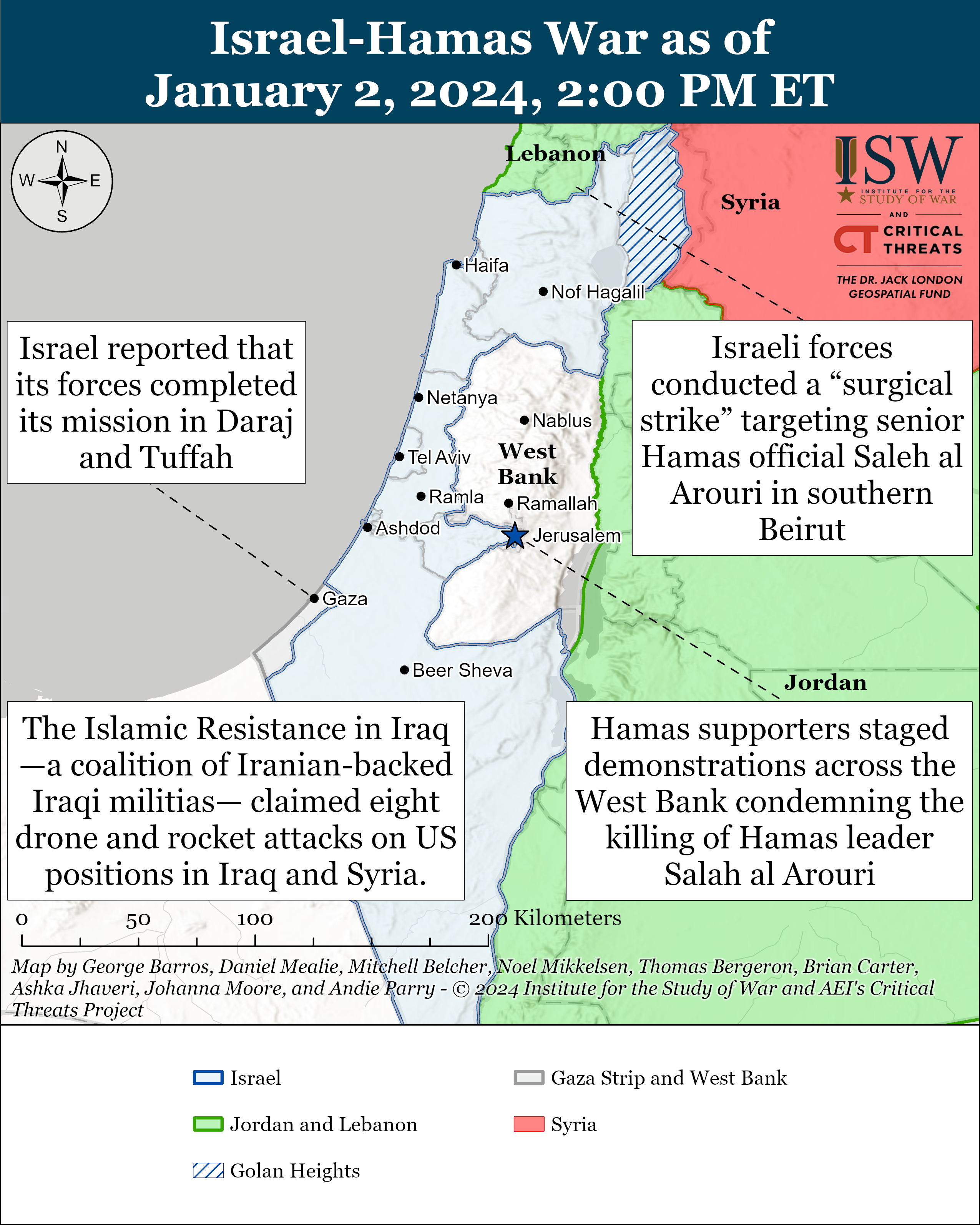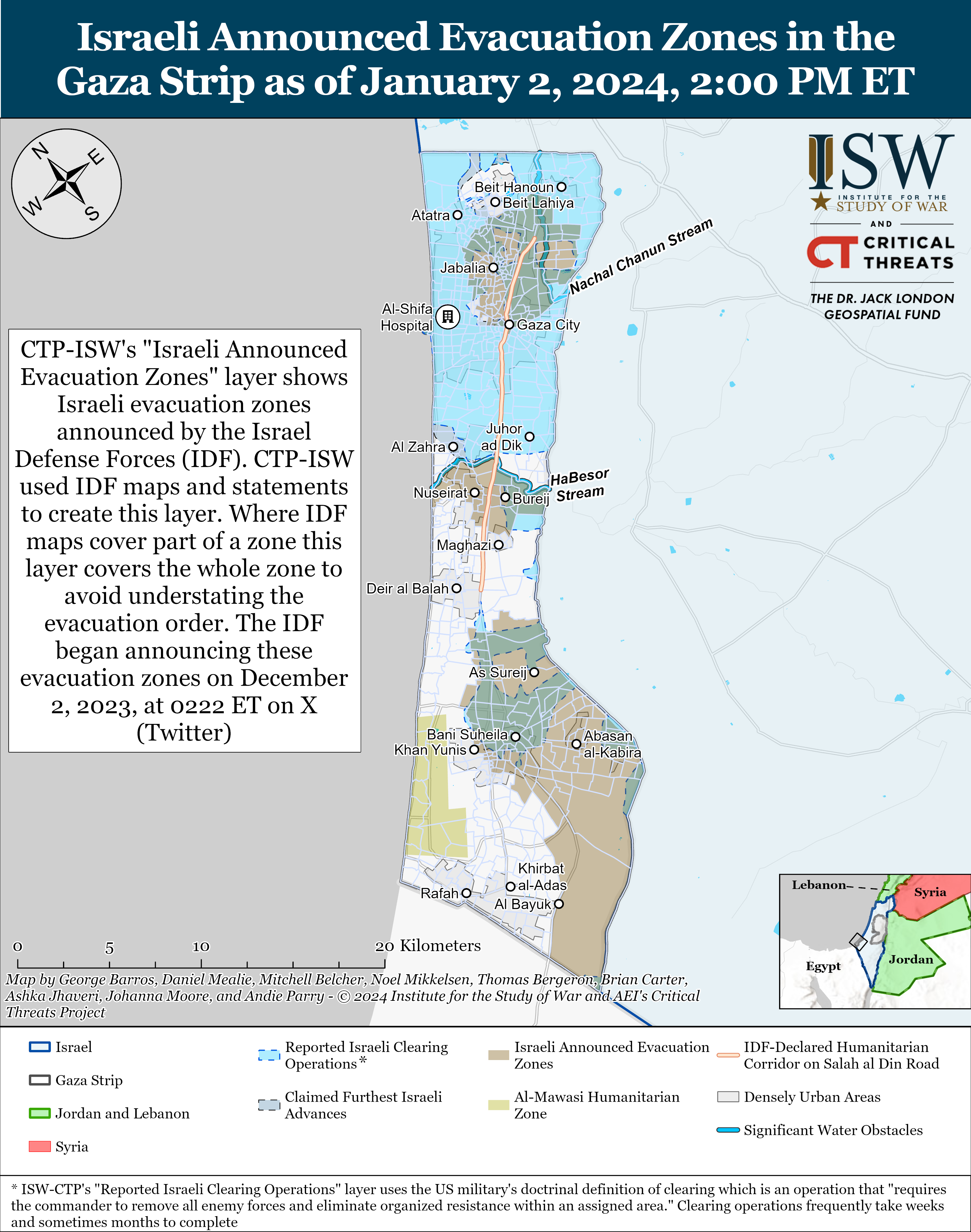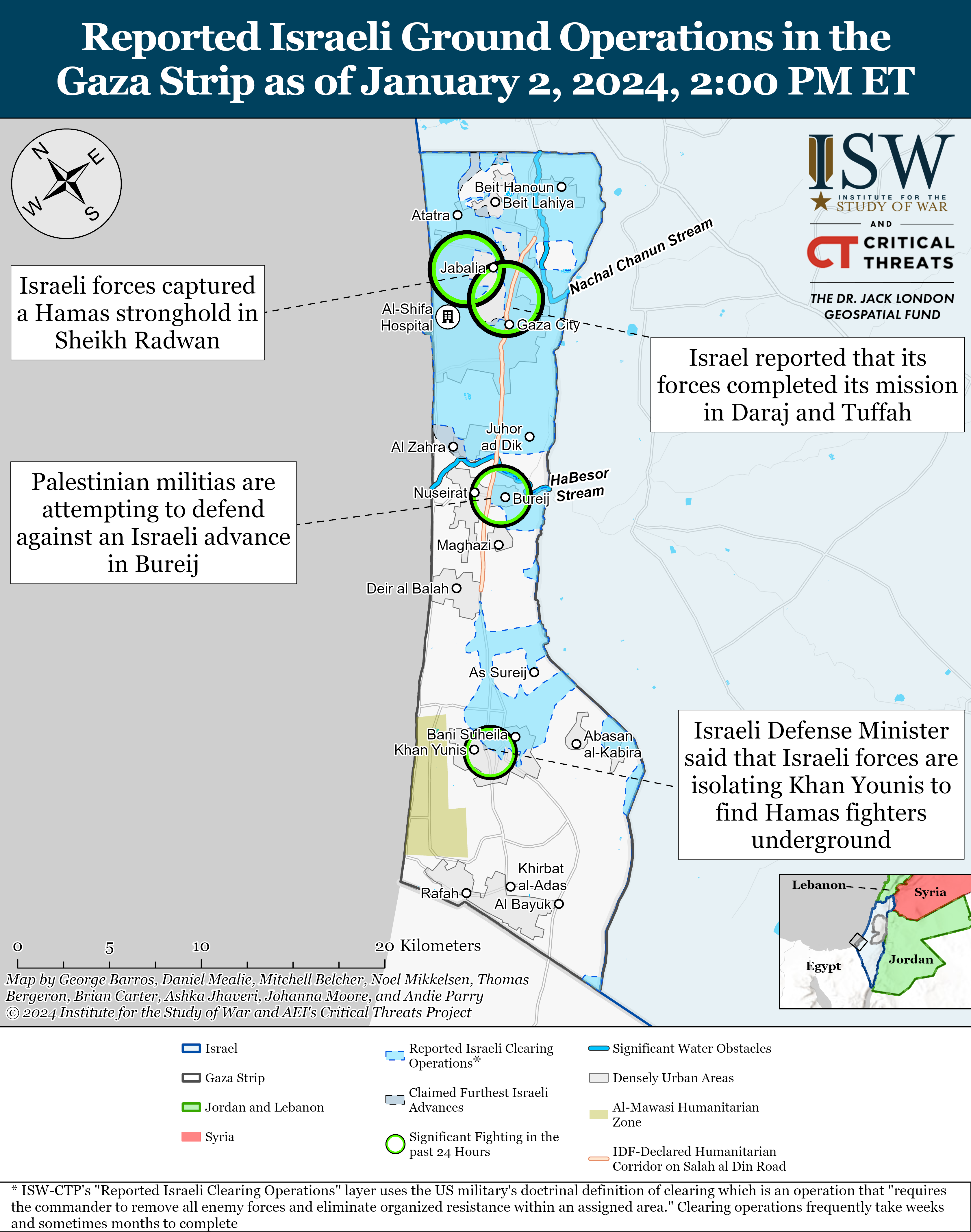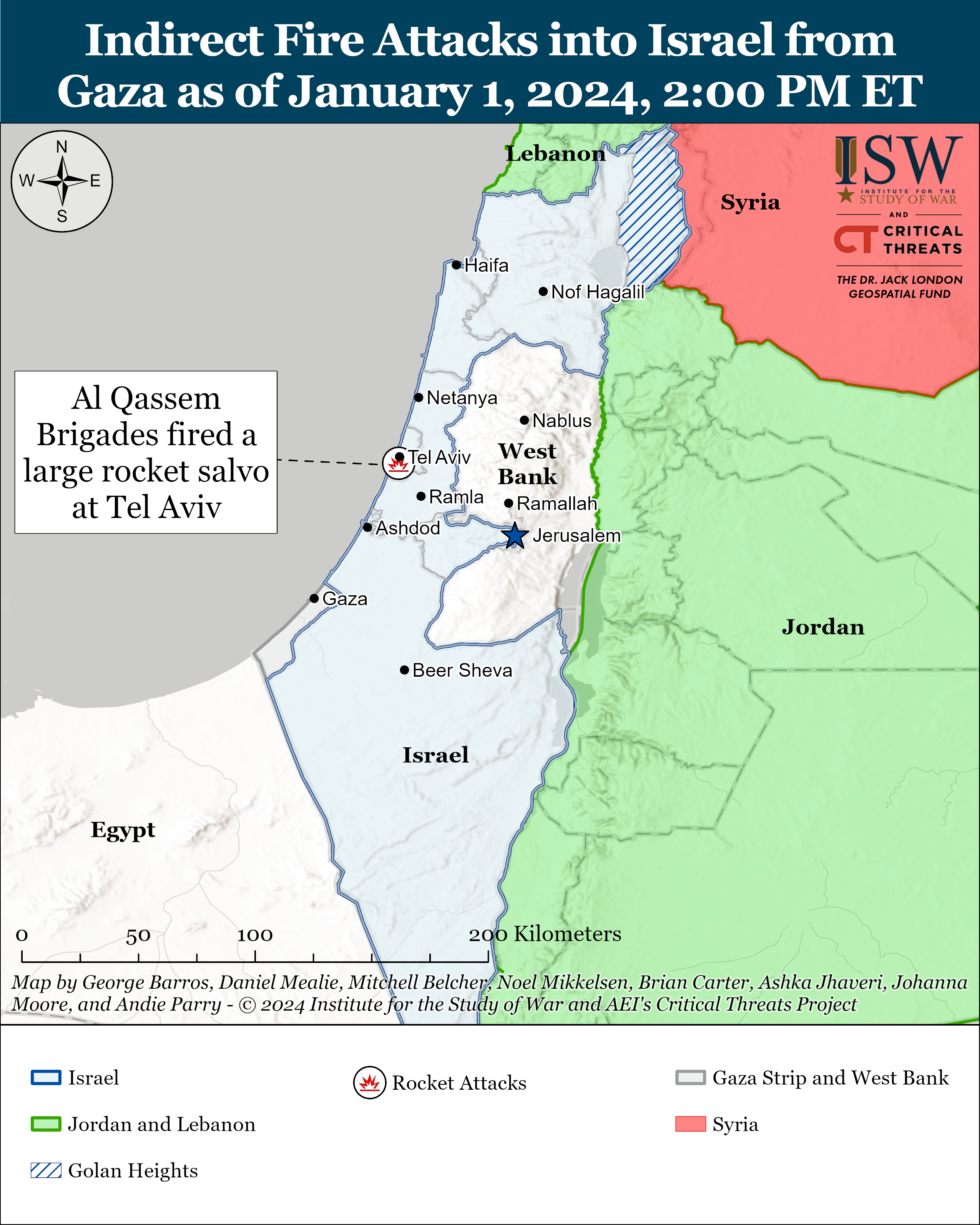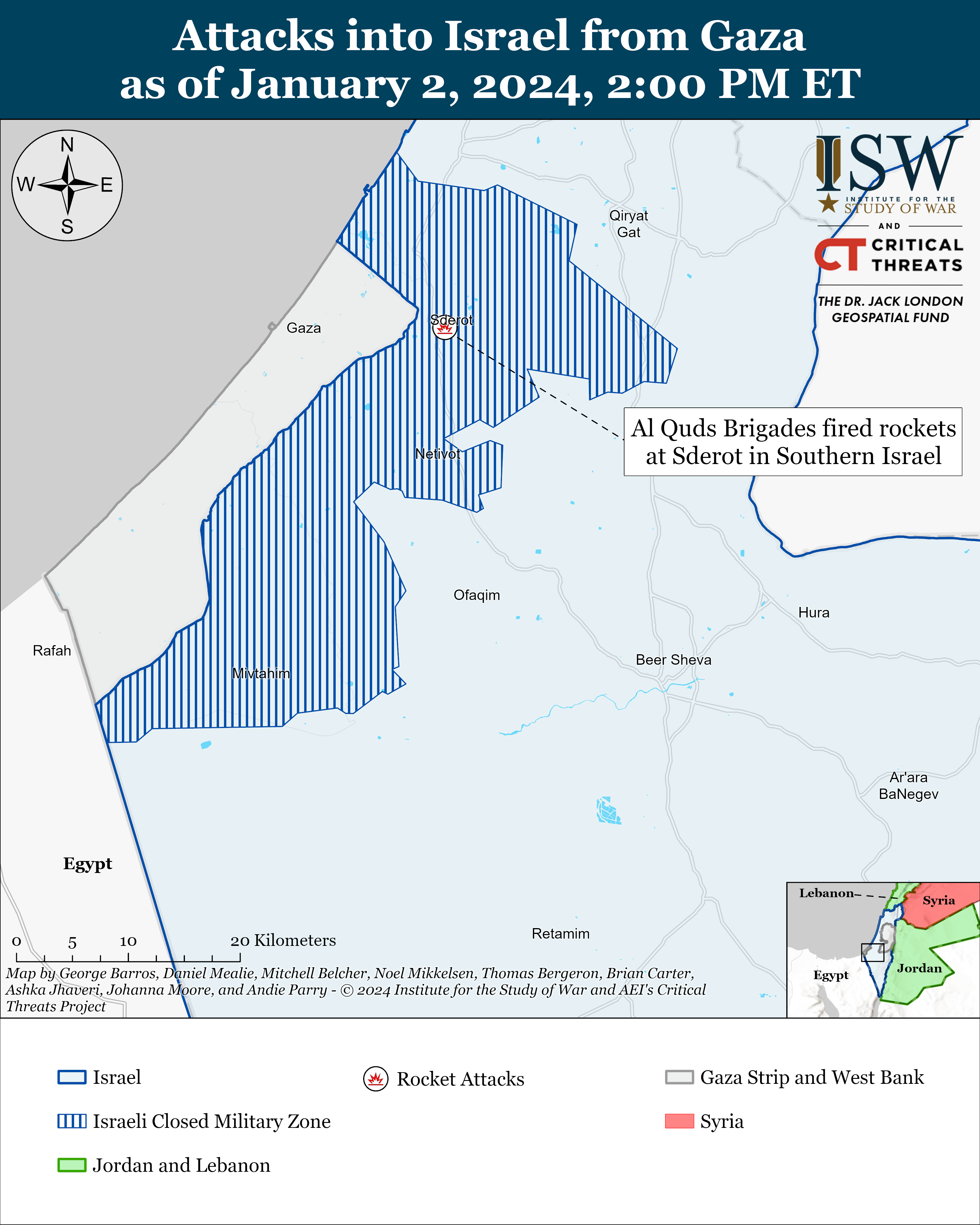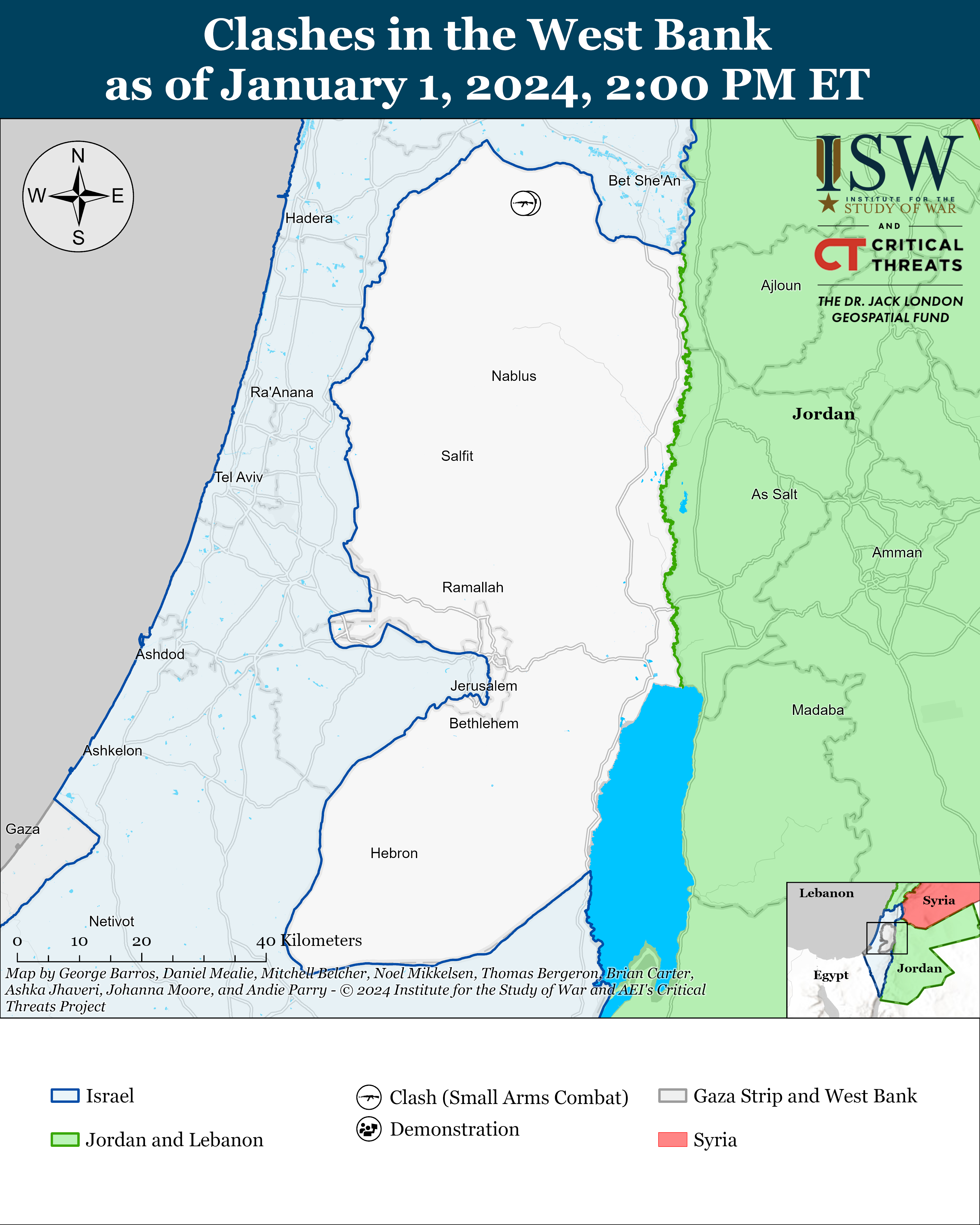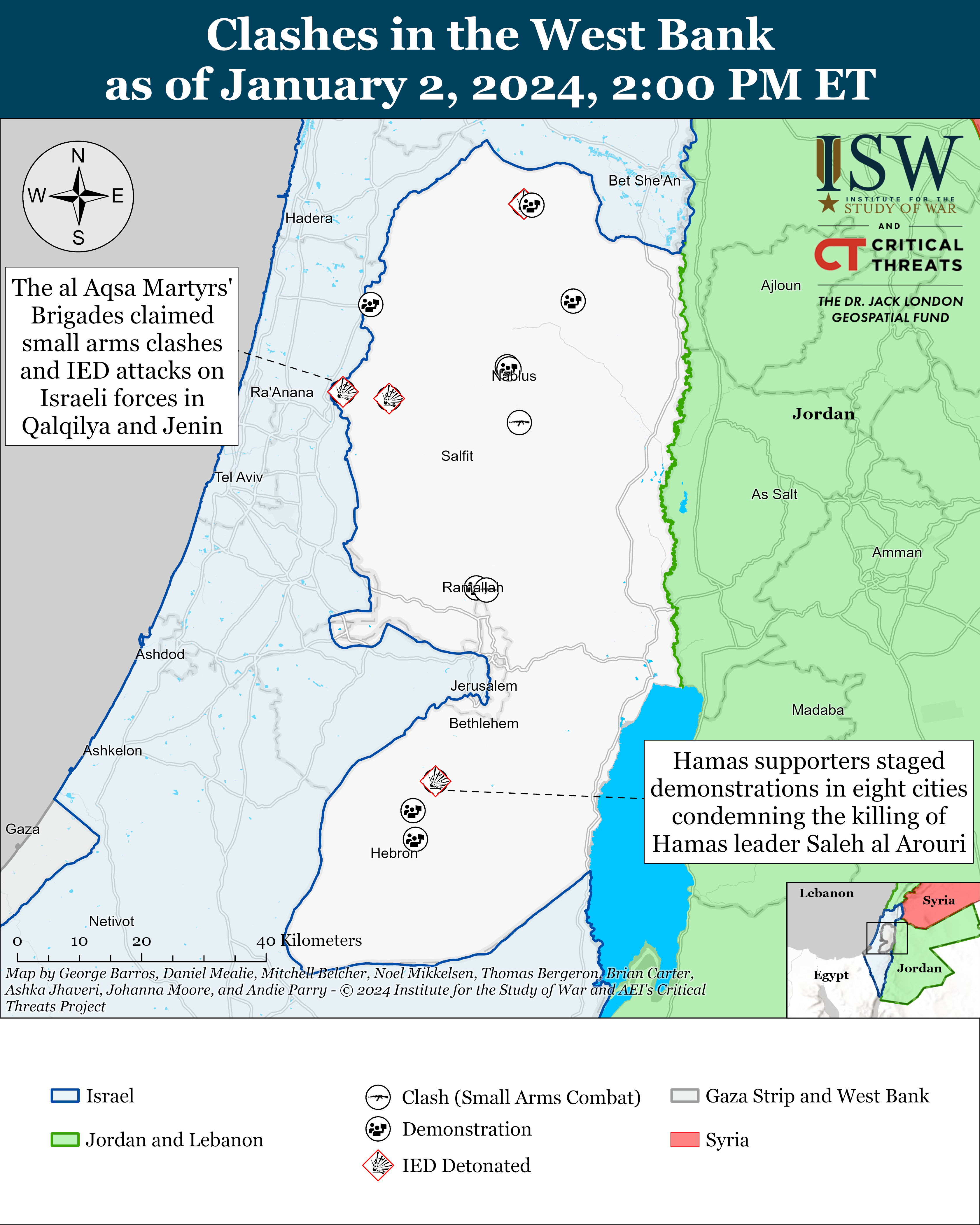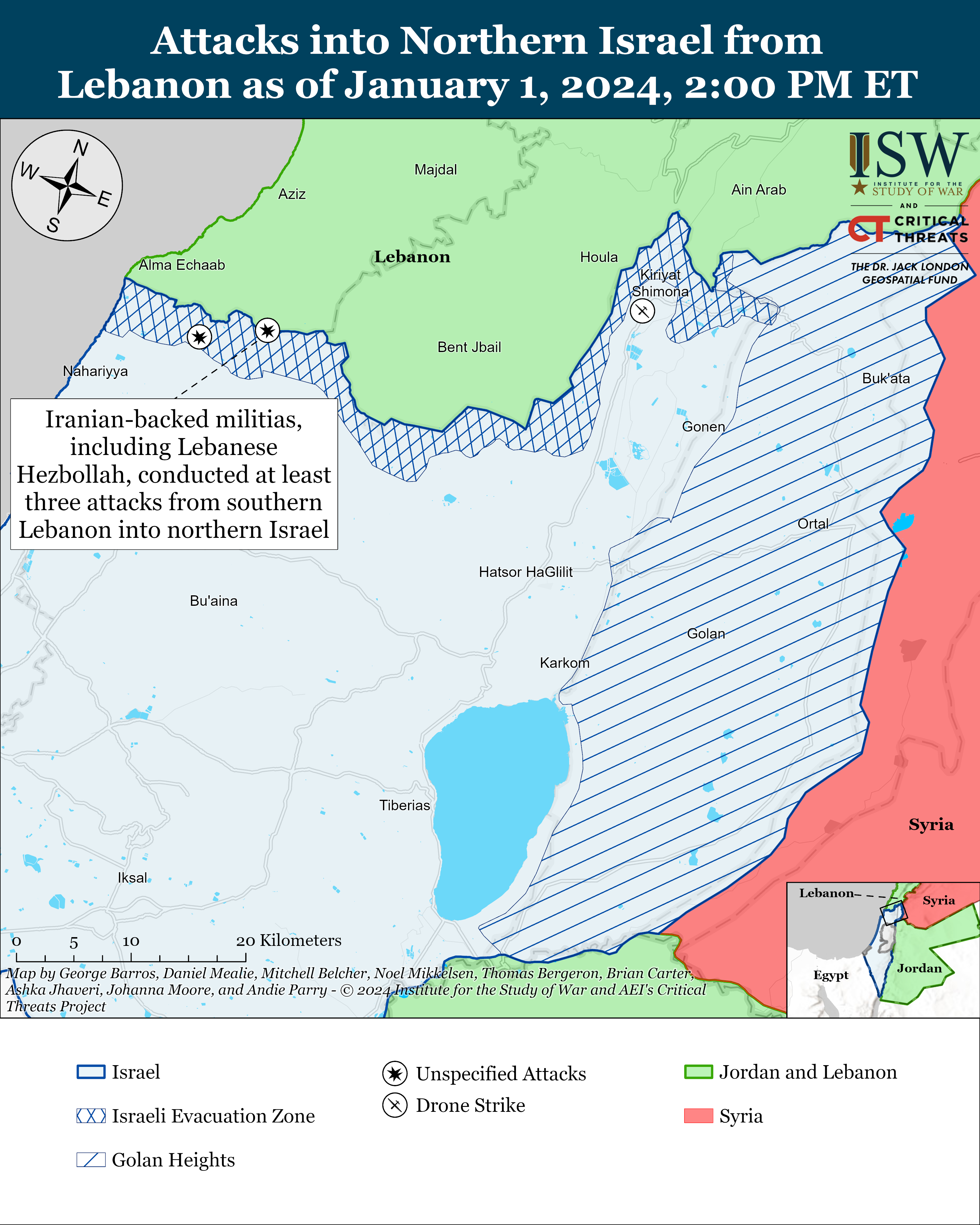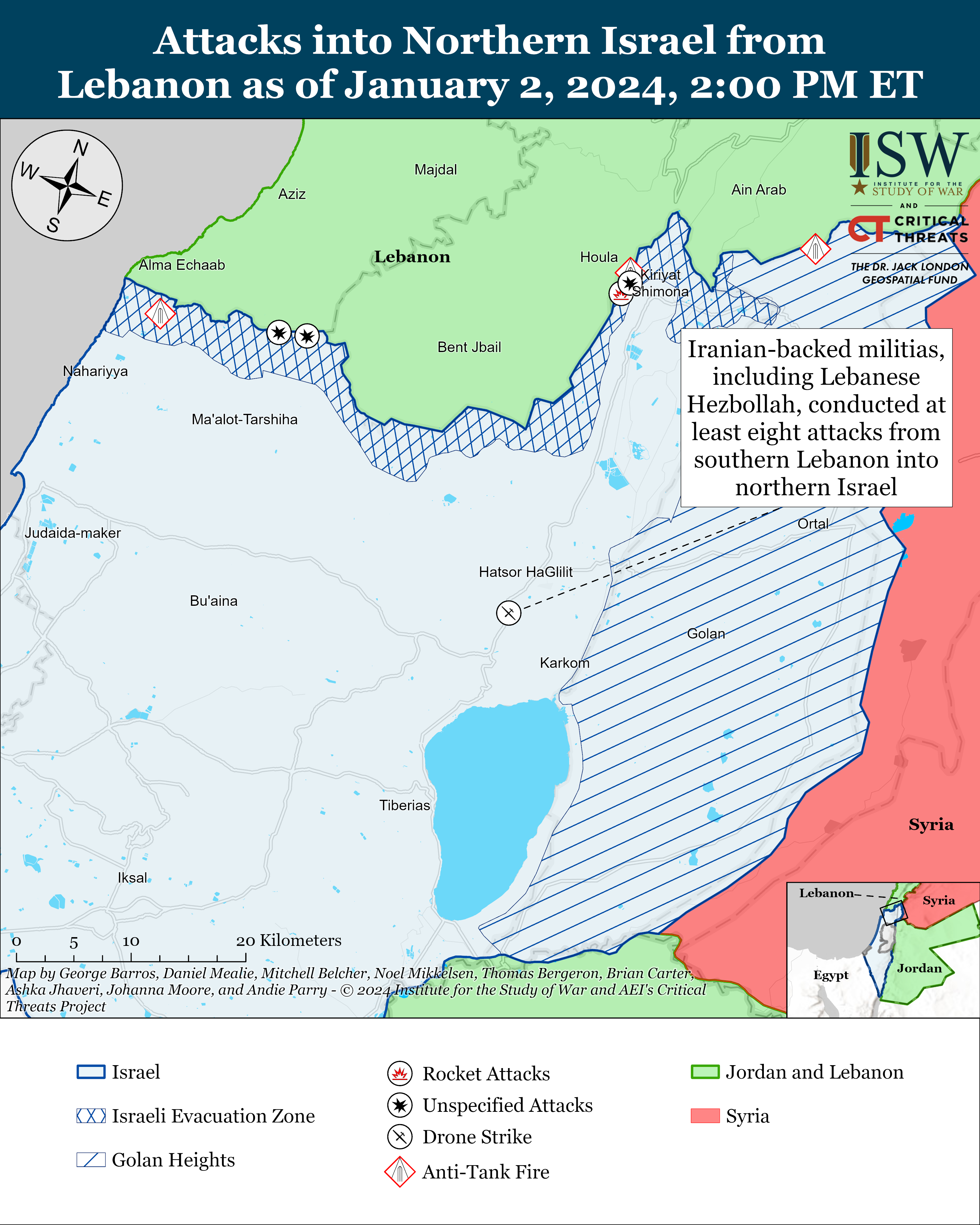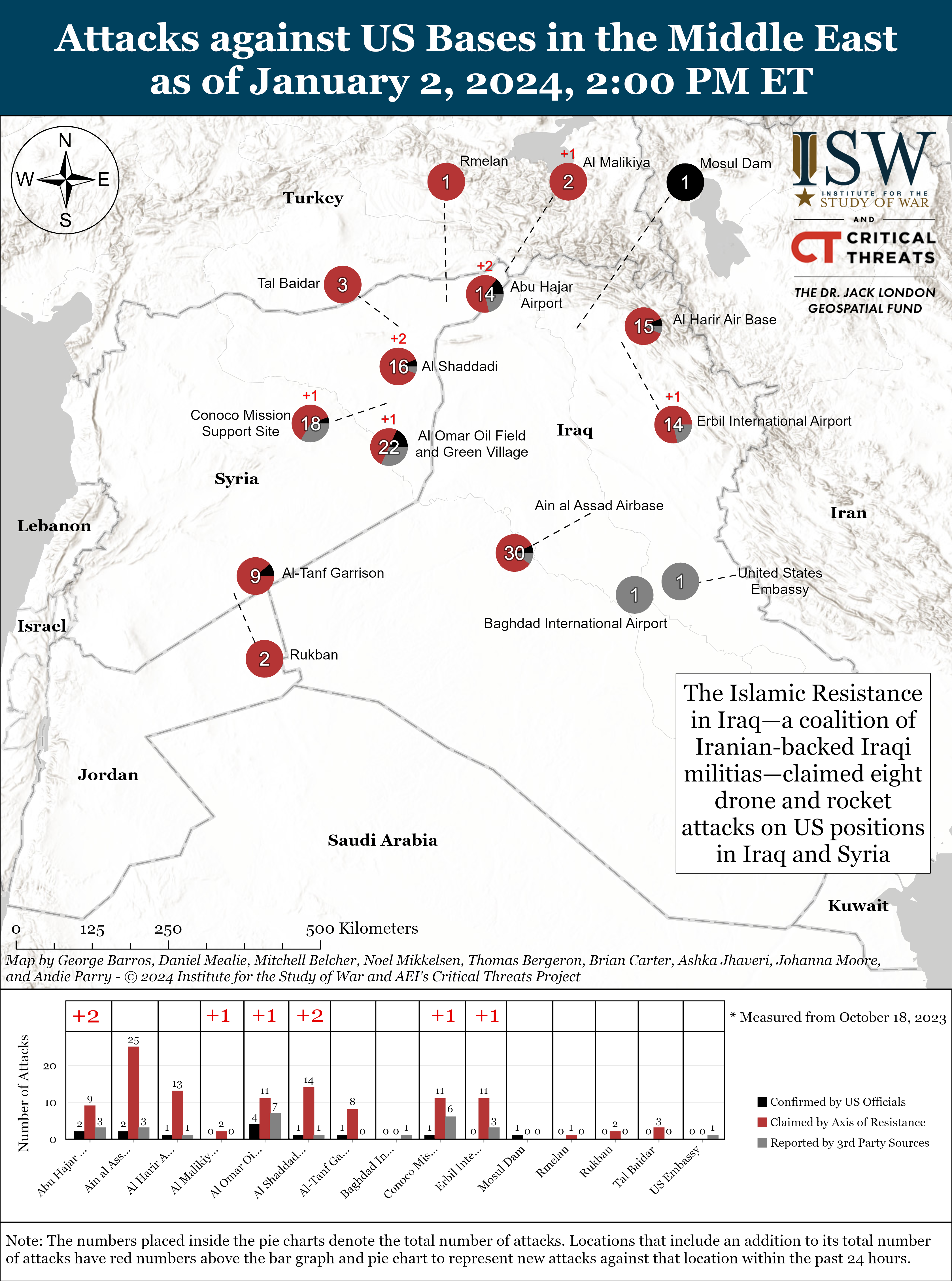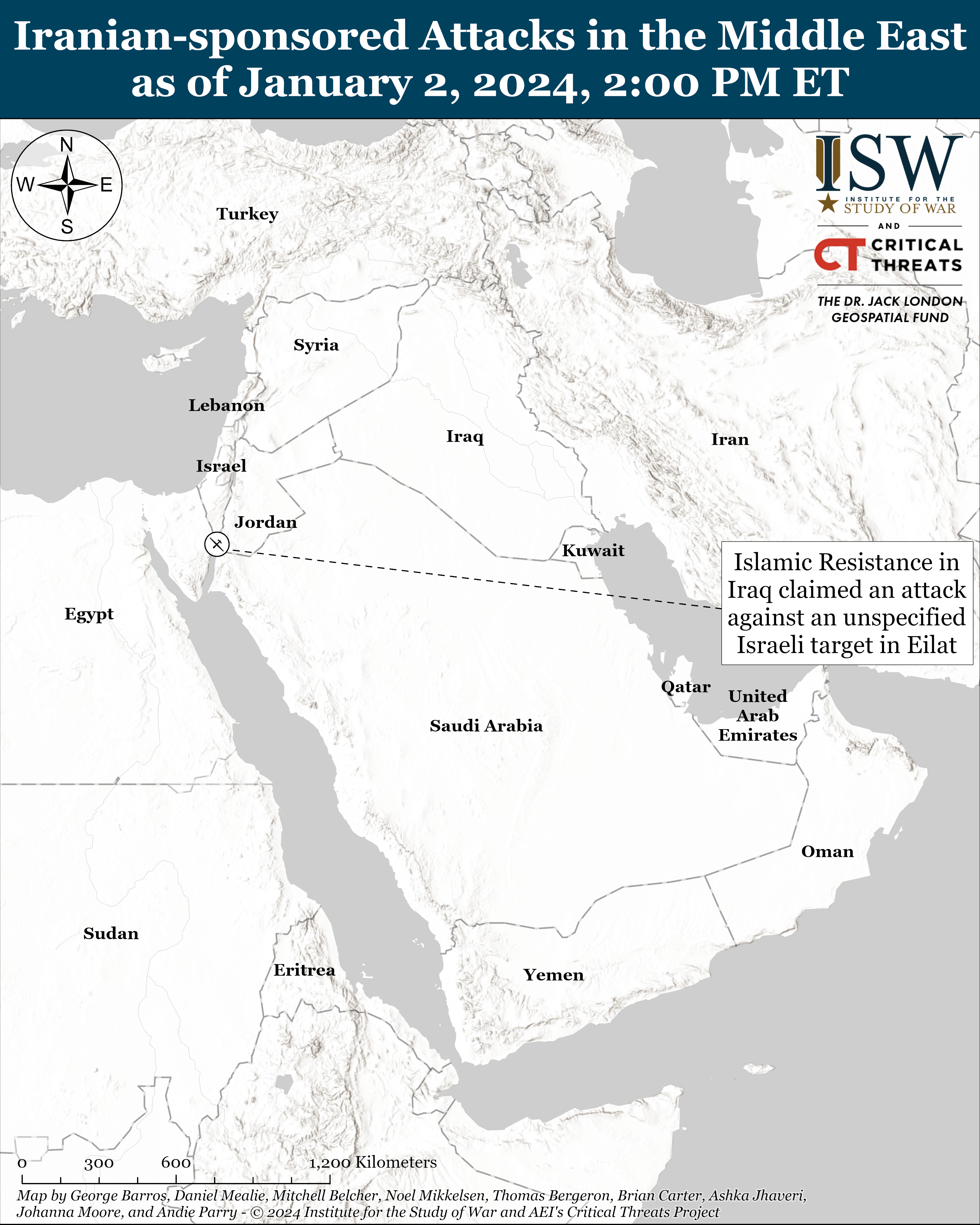Iran Update, January 2, 2024
Ashka Jhaveri, Brian Carter, Annika Ganzeveld, Amin Soltani, Alexandra Braverman, Peter Mills, and Nicholas Carl
Information Cutoff: 2:00 pm EST
The Iran Update provides insights into Iranian and Iranian-sponsored activities abroad that undermine regional stability and threaten US forces and interests. It also covers events and trends that affect the stability and decision-making of the Iranian regime. The Critical Threats Project (CTP) at the American Enterprise Institute and the Institute for the Study of War (ISW) provides these updates regularly based on regional events. For more on developments in Iran and the region, see our interactive map of Iran and the Middle East.
Note: CTP and ISW have refocused the update to cover the Israel-Hamas war. The new sections address developments in the Gaza Strip, the West Bank, Lebanon, and Syria, as well as noteworthy activity from Iran’s Axis of Resistance. We do not report in detail on war crimes because these activities are well-covered in Western media and do not directly affect the military operations we are assessing and forecasting. We utterly condemn violations of the laws of armed conflict and the Geneva Conventions and crimes against humanity even though we do not describe them in these reports.
Click here to see CTP and ISW’s interactive map of Israeli ground operations. This map is updated daily alongside the static maps present in this report.
Key Takeaways:
- Israeli forces are transitioning to the third phase of their operations in the northern Gaza Strip, which will very likely enable Hamas to reconstitute itself militarily. Iran and its so-called “Axis of Resistance” will very likely continue their regional escalation against the United States and Israel, despite Israel withdrawing some of its forces from the Gaza Strip.
- Israeli forces conducted a “surgical strike” targeting senior Hamas official Saleh al Arouri in southern Beirut. LH harbors Hamas and Palestinian Islamic Jihad (PIJ) officials in Lebanon and permits them to conduct attacks into Israel.
- Israeli forces raided a Hamas and PIJ command and control center in Gaza City’s Shujaiya neighborhood.
- Israeli forces captured a Hamas compound in Sheikh Radwan neighborhood of Gaza City.
- Palestinian militias are attempting to defend against Israeli advances in Bureij in the central Gaza Strip.
- Israeli Defense Minister Yoav Gallant said that Israeli forces are “isolating” Khan Younis to find Hamas fighters underground.
- Israel rejected a Hamas-proposed, three-phase hostage-for-prisoner deal. The proposal is not compatible with Israeli war aims, as CTP-ISW has previously noted.
- The al Qassem Brigades fired a large salvo of rockets at Tel Aviv.
- Israeli forces clashed with Palestinian fighters in Jenin following demonstrations organized by Palestinian militia groups on January 1. Israeli forces clashed with Palestinian fighters in eight locations across the West Bank on January 2.
- Iranian-backed militias, including Lebanese Hezbollah, conducted at least three attacks from southern Lebanon into northern Israel on January 1 and another eight attacks on January 2.
- The Islamic Resistance in Iraq—a coalition of Iranian-backed Iraqi militias—claimed that it conducted eight drone and rocket attacks targeting US positions in Iraq and Syria. The group also claimed an unspecified attack targeting Eilat in southern Israel.
- Iranian Foreign Affairs Minister Hossein Amir Abdollahian met with senior Houthi official Mohammad Abdul Salam in Tehran.
Israeli forces are transitioning to the third phase of their operations in the northern Gaza Strip, which will very likely enable Hamas to reconstitute itself militarily. The Israel Defense Forces (IDF) confirmed that it withdrew five brigades from the northern Gaza Strip on December 31.[1] This reduction in forces is part of what the IDF has described as its third phase in the strip, which also involves ending major combat operations, releasing reservists, transitioning to “targeted raids,” and establishing a security buffer zone within the Gaza Strip.[2] Israeli forces have degraded several Hamas units and rendered others combat ineffective, particularly in the northern Gaza strip, since the beginning of the clearing operations.[3] But Hamas’ military forces are neither defeated nor destroyed at this time. Decreased Israeli pressure would, in fact, allow Hamas to rebuild its military capabilities and infrastructure. Hamas maintains a conventional military structure, meaning that it should be able to quickly replace commanders who have died in the war.[4] Several recently killed Hamas battalion and brigade commanders had led their units for many years, suggesting that they had the ability and time to develop successors to take their place.[5] Such reconstitution is inconsistent with the stated Israeli war aims, which are to destroy Hamas militarily and politically.[6]
Iran and its so-called “Axis of Resistance” will very likely continue their regional escalation against the United States and Israel, despite Israel withdrawing some of its forces from the Gaza Strip. Iran and its regional network of proxies and partners have conducted almost daily attacks targeting American servicemembers and international shipping across the Middle East in recent months. They have framed their attacks as responses to Israeli operations in the Gaza Strip and US support for Israel. This escalation is, in actuality, meant to support Tehran’s regional project. Iranian leaders have long used their Axis of Resistance to threaten US personnel and commercial traffic in the Middle East because doing so supports the long-standing Iranian objectives of attaining regional hegemony and expelling the US military from the region.
Israeli forces conducted a “surgical strike” targeting senior Hamas official Saleh al Arouri in southern Beirut on January 2.[7] Arouri was the deputy chairman of Hamas‘ political bureau and a US-designated global terrorist responsible for “directing Hamas military operations in the West Bank.”[8] Arouri helped found Hamas’ military wing in the West Bank.[9] Hamas confirmed that the strike killed Arouri as well as the top al Qassem Brigades commander for Lebanon.”[10] Lebanese Hezbollah (LH)-affiliated media reported that two al Qassem Brigades commanders in addition to Arouri died in the airstrike.[11] An Israeli journalist reported that a senior IDF official told them that Israeli is prepared “for a very significant response” to the Arouri strike, including from LH.[12]
LH harbors Hamas and Palestinian Islamic Jihad (PIJ) officials in Lebanon and permits them to conduct attacks into Israel. Both Hamas and PIJ have conducted cross-border attacks from southern Lebanon into northern Israel since October 7.[13] LH controls southern Lebanon and probably approved Hamas and PIJ to conduct these attacks, as CTP has previously assessed.[14] Hamas and PIJ’s presences in Lebanon also allow them to coordinate with LH and Iranian officials.[15] One of Arouri’s roles within Hamas was coordinating with Iranian officials and LH on behalf of Hamas, for example.[16]
Gaza Strip
Axis of Resistance campaign objectives:
- Erode the will of the Israeli political establishment and public to launch and sustain a major ground operation into the Gaza Strip
- Degrade IDF material and morale around the Gaza Strip.
The commander of the IDF 460th Brigade reported on January 2 that his brigade completed its mission in Daraj and Tuffah neighborhoods of Gaza City after destroying militia infrastructure belonging to Hamas’ Gaza City Brigade.[17] The IDF announced that it was operating in Daraj and Tuffah on December 21.[18] Palestinian militias have claimed regular attacks on Israeli forces in the area since then. The IDF reported on January 2 that its forces raided the Hamas Gaza City Brigade commander’s home and destroyed several arms caches and tunnels
Palestinian militias claimed several attacks on Israeli forces in Daraj and Tuffah on January 1 before the IDF said that it accomplished its mission there.[19] The al Qassem Brigades—the militant wing of Hamas—detonated a minefield targeting Israeli special operations forces (SOF) east of Tuffah.[20] The militia also claimed that it fired a thermobaric rocket at Israeli SOF inside a building in Tuffah.[21] The al Quds Brigades—the militant wing of PIJ—published footage of its fighters firing rocket-propelled grenades (RPG) at Israeli tanks in Tuffah.[22] The IDF published captured footage of Hamas fighters in Hamas’ Daraj wal Tuffah Battalion firing rockets from civilian homes amid fighting between the IDF and Hamas in the past week.[23]
Israeli forces raided a Hamas and PIJ command and control center in Gaza City’s Shujaiya neighborhood on January 1.[24] Hamas and PIJ have coordinated their operations against Israeli forces in the Gaza Strip throughout the Israel-Hamas war.[25] The IDF also said on January 1 that it conducted an airstrike targeting Palestinian fighters who had fired mortars at Israeli forces.[26]
Israeli forces captured a Hamas compound in Sheikh Radwan neighborhood of Gaza City on January 2. The IDF reported that it engaged Hamas fighters inside a tunnel network beneath the compound before capturing it.[27] The complex includes 37 buildings around other residential buildings, schools, and hospitals.[28] Israeli forces uncovered an underground Hamas operations room where commanders ”conducted the fighting in the Gaza Strip.”[29] The Jerusalem Post separately reported that the IDF took over the second most important Hamas intelligence center in the northern Gaza Strip.[30]
Palestinian militias are attempting to defend against Israeli advances in Bureij in the central Gaza Strip. The IDF reported on January 2 that its forces found tunnel shafts, intelligence materials, and weapons in Bureij during clearing operations.[31] The al Qassem Brigades claimed that its forces ambushed Israeli SOF inside a house in Bureij on January 1 using small arms and other unspecified weapons.[32] The militia claimed another ambush targeting five Israeli soldiers using hand grenades and small arms fire.[33] The al Qassem Brigades, al Quds Brigades, and al Aqsa Martyrs’ Brigades—the self-proclaimed militant wing of Fatah—separately claimed several other attacks targeting Israeli forces and tanks using anti-tank rockets, mortars, rockets, and small arms.[34]
Israeli Defense Minister Yoav Gallant said on January 2 that Israeli forces are “isolating” Khan Younis to find Hamas fighters underground.[35] Gallant added that high-intensity fighting will continue in the southern Gaza Strip for an unspecified period of time.[36] Israeli forces have been conducting clearing operations in Khan Younis City for several weeks at this point.
Palestinian militias are attempting to defend against Israeli forces in Khan Younis City and areas east of the city. The IDF reported on January 2 that its forces engaged Palestinian fighters last week in Bani Suheila after Palestinian fighters fired at Israeli forces and attempted to attach IEDs to Israeli vehicles.[37] The al Qassem Brigades attempted to defend against Israeli advances on January 1 and January 2 in Qarara, which is east of the Salah al Din road.[38] The group targeted Israeli infantrymen by detonating a tunnel rigged with explosives in Qarara. The al Qassem brigades also detonated a house-borne improvised explosive device (IED) targeting Israeli forces holding a building.[39] The al Qassem Brigades and al Quds Brigades claimed attacks on Israeli forces in Maan east of Khan Younis.[40]
Other Palestinian militias are also attempting to defend against Israeli clearing operations in Khan Younis. The al Aqsa Martyrs’ Brigades mortared Israeli forces and fired RPGs targeting Israeli tanks in several attacks.[41] The National Resistance Brigades fired RPGs and small arms at Israeli forces in Khan Younis.[42]
The IDF reported on January 1 that its forces killed a regional commander from Hamas’ naval commando forces, the Nukhba forces in Deir al Balah.[43] The commander, Adil Mismash, directed attacks into Kissufim during Hamas’ October 7 attack.[44]
Israel rejected a Hamas-proposed, three-phase hostage-for-prisoner deal.[45] The three-phase process included a pause in fighting for over a month in exchange for Hamas releasing 40 Israeli hostages, according to an Israeli official. Israel would also withdraw its forces from the Gaza Strip during the first phase of the deal. The proposal would end the war following the implementation of the last phase, which would include Hamas releasing Israeli soldiers currently held hostage in the Gaza Strip. The Israeli official said that the Israeli war cabinet rejected the proposal.[46] The proposal is not compatible with Israeli war aims, as CTP-ISW has previously noted.
Israeli Prime Minister Benjamin Netanyahu said on January 2 that Hamas’ stance regarding an ultimatum has “slightly softened.”[47] Hamas has repeatedly demanded that Israel must withdraw its forces from the Gaza Strip and agree to a permanent ceasefire as a pre-condition to hostage negotiations.[48]
Recorded reports of rocket attacks; CTP-ISW cannot independently verify impact.
Recorded reports of rocket attacks; CTP-ISW cannot independently verify impact.
The al Qassem Brigades fired a large salvo of rockets at Tel Aviv on December 31, 2023.[49] The launch demonstrates that Palestinian militias retain some capacity to reach Tel Aviv with rockets, despite Israeli clearing operations. The militia published a video on December 31 showcasing its rocket arsenal, which included several munitions that are allegedly able to reach Tel Aviv from the Gaza Strip.[50] The IDF found long-range rockets that are capable of hitting Tel Aviv during clearing operations in Bureij in the central Gaza Strip.[51]
The Washington Institute for Near East Policy reported on December 21 that the al Qassem Brigades fired a large salvo of rockets toward Tel Aviv as part of Hamas leader in the Gaza Strip Yahya Sinwar messaging dissatisfaction to Hamas Political Bureau Chairman Ismail Haniyeh. Sinwar was dissatisfied that the peace negotiations with Israel did not include a precondition that Israeli forces would withdraw completely from the Gaza Strip before Hamas released any Israeli hostages, according to the report.[52]
The al Quds Brigades fired several rockets into southern Israel on January 2.[53] An Israeli media military correspondent noted that the attack occurred after a lull of nearly 42 hours.[54]
West Bank
Axis of Resistance campaign objectives:
- Draw IDF assets and resources toward the West Bank and fix them there
Israeli forces clashed with Palestinian fighters in Jenin following demonstrations organized by Palestinian militia groups on January 1. The Jenin Battalion organized a demonstration against Israeli operations in the Gaza Strip.[55] The Hornets’ Nest, which is a militia affiliated with the al Aqsa Martyrs’ Brigades, said that its forces fired small arms at Israeli forces in Jenin on January 1.[56]
Israeli forces clashed with Palestinian fighters in eight locations across the West Bank on January 2.[57] The al Aqsa Martyrs’ Brigades claimed that they conducted IED and small arms attacks targeting Israeli forces conducting raids in Jenin and Qalqilya on January 2.[58] Unspecified Palestinian fighters detonated IEDs and engaged in small arms clashes with Israeli forces in Azzun on January 2.[59] These attacks injured one IDF officer.
Hamas supporters demonstrated across the West Bank on January 2, condemning Israel for killing Hamas Political Bureau Deputy Chairman Saleh al Arouri in Beirut.[60] Palestinian fighters fired on an Israeli settlement near Ramallah and detonated IEDs targeting Israeli forces in Hebron after some of the demonstrations.[61]
This map is not an exhaustive depiction of clashes and demonstrations in the West Bank.
This map is not an exhaustive depiction of clashes and demonstrations in the West Bank.
Southern Lebanon and Golan Heights
Axis of Resistance campaign objectives:
- Draw IDF assets and resources toward northern Israel and fix them there
- Set conditions for successive campaigns into northern Israel
Iranian-backed militias, including Lebanese Hezbollah (LH), conducted at least three attacks from southern Lebanon into northern Israel on January 1. LH claimed that it conducted two attacks targeting Israeli military positions in northern Israel.[62] Israeli air defense intercepted one “suspicious aerial target” near Kiryat Shmona in northern Israel.[63]
Iranian-backed militias, including LH, conducted at least eight attacks from southern Lebanon into northern Israel on January 2.[64] LH claimed that it conducted six attacks targeting Israeli military positions in northern Israel.[65] Unknown fighters also launched one rocket salvo targeting Margaliot.[66]
Iran and Axis of Resistance—
Axis of Resistance campaign objectives:
- Demonstrate the capability and willingness of Iran and the Axis of Resistance to escalate against the United States and Israel on multiple fronts
- Set conditions to fight a regional war on multiple fronts
The Islamic Resistance in Iraq—a coalition of Iranian-backed Iraqi militias—claimed that it conducted eight drone and rocket attacks targeting US positions in Iraq and Syria on January 1 and 2.[67] This attack rate is consistent with CTP-ISW’s assessment that the Axis of Resistance would increase its attacks against US forces in Iraq and Syria around the anniversary of the United States killing of Qassem Soleimani on January 3.[68]
- The Islamic Resistance in Iraq claimed a one-way drone attack targeting US forces at Erbil International Airport in Iraq on January 2.[69]
- The Islamic Resistance in Iraq claimed that it fired a rocket salvo at the Conoco Mission Support Site in Syria on January 1.[70]
- The Islamic Resistance in Iraq claimed a one-way drone attack targeting US forces in al Malikiyah, Syria on January 2.[71]
- The Islamic Resistance in Iraq claimed a single one-way drone attack targeting US forces at al Shaddadi, Hasakah Province, Syria on January 1 and another one-way drone attack on the same location on January 2.[72]
- The Islamic Resistance in Iraq conducted a one-way drone attack targeting US forces at al Omar oilfield in Syria on January 2.[73]
- The Islamic Resistance in Iraq claimed two one-way drone attacks targeting US forces at Rumaylan Landing Zone in Syria on January 2.[74]
The Islamic Resistance in Iraq additionally claimed an unspecified attack targeting Eilat in southern Israel on December 31, 2023, in support of Palestinians in the Gaza Strip.[75]
Iraqi Popular Mobilization Forces Chairman Faleh al Fayyadh met with interim Ninewa Governor Abdul Qadir al Dakhil on January 1 to discuss plans to transfer security responsibilities from the Iraqi Defense Ministry to Interior Ministry.[76] The Iraqi Army Chief of Staff announced on December 27 that the Iraqi Army will complete the transfer of security responsibilities to local police in 2024.[77] Fayyadh and Dakhil discussed the impact that this transfer of responsibilities will have on Ninewa’s “stability and reconstruction.” Iraqi Prime Minister Mohammad Shia al Sudani appointed Dakhil to replace Najm al Jubouri as the acting governor of Ninewa in November 2023.[78] Iranian-backed Iraqi militia Kataib Hezbollah (KH) members escorted Dakhil in Ninewa after his appointment.[79] Dakhil also met with Fayyadh in mid-December 2023 to discuss improving security in Ninewa Province for the provincial council elections.[80]
A legal committee appointed by Iraqi Prime Minister Mohammad Shia al Sudani has submitted to him draft legislation that would empower the Iraqi Federal Supreme Court, according to a constitutional adviser to Sudani.[81] The committee is composed of representatives from the Presidential Office, State Shura Council, and General Secretariat of the Council of Ministers.[82] Sudani stated on December 27 that the draft law will affirm his administration’s commitment to following the Iraqi constitution, which he claimed “grants the Federal Supreme Court more authorities than it currently holds.”[83] Sudani’s claim that the Federal Supreme Court currently possesses insufficient power is surprising given that the court has recently engaged in actions that appear to exceed its constitutional powers. The Federal Supreme Court dismissed then-Parliament Speaker Mohammad al Halbousi in November 2023, citing Article 94 of the Iraqi constitution.[84] Article 94 states that “the decisions of the Federal Supreme Court are final and binding for all authorities” but does not explicitly give the court the authority to remove parliament speakers from office.[85] CTP-ISW previously assessed that the court likely removed Halbousi from his post as part of Iranian-backed political efforts to reduce the US presence in Iraq.[86]
Iranian-backed Iraqi Shia actors have historically co-opted elements of the Iraqi judiciary to politically benefit themselves and disadvantage opponents, especially in recent years.[87] Iraq has a sectarian power-sharing system in which the prime minister is always Shia, the parliament speaker is Sunni, and the president is Kurdish.[88] This Iranian-backed control of the judiciary would enable Iranian-backed actors to exercise more power than the power-sharing system currently grants them. Controlling the judiciary would enable these actors to bypass checks and balances, thereby granting them informal control over the Iraqi federal government.
Iraq’s Independent High Electoral Commission (IHEC) issued fines for electoral campaign violations to four candidates in the Design Alliance on January 2, including current Basra Governor Asad al Eidani.[89] The Design Alliance won 12 out of 23 seats in Basra Province in the recent provincial council elections.[90] IHEC announced that the Integrity Commission and Financial Supervision Bureau will investigate the violations. IHEC’s announcement follows reports that members of the Shia Coordination Framework—a loose coalition of Iranian-backed political parties—are maneuvering to try to prevent Eidani from retaining the governorship in Basra. Informed sources told an independent Iraqi news outlet on December 27 that members of the Shia Coordination Framework are lobbying the Iraqi judiciary to rule that a majority of seats in Basra requires 13—not 12—seats.[91] Such a decision would deprive Eidani’s party of a majority. The independent Iraqi outlet reported that the Shia Coordination Framework is suspicious of Eidani’s ties to rival Shia cleric Muqtada al Sadr. Sadr has previously praised Eidani and members of the Design Alliance.[92]
The Iranian Defense and Armed Forces Logistics Ministry reiterated that expelling the United States from the Middle East is one of Iran’s primary strategic objectives in a statement commemorating the fourth anniversary of the United States killing Qassem Soleimani.[93] The ministry praised Soleimani for his role in developing the Axis of Resistance and confronting the United States and Israel. Iranian military leaders have repeatedly vowed to expel US forces from the region as part of their revenge for Soleimani’s death.[94]
IRGC-affiliated media reported on January 1 that the Artesh Navy Alborz destroyer entered the Red Sea on January 1.[95] The Artesh is Iran’s conventional military and has larger surface combatants than the IRGC. The Alborz has routinely conducted “anti-piracy” operations in the area since 2010 and operated around the Red Sea at least since December 2023.[96] Both the Artesh and IRGC navies maintain a regular presence in the Red Sea and have done so for over a decade.[97]
Iranian Foreign Affairs Minister Hossein Amir Abdollahian met with senior Houthi official Mohammad Abdul Salam in Tehran on January 1.[98] Abdollahian thanked Abdul Salam for his “strong” position supporting Palestinians. Abdul Salam thanked Abdollahian for Iran’s continued support for the Axis of Resistance. Abdul Salam is the chief Houthi negotiator engaging Saudi Arabia to end the ongoing war in Yemen.
Iranian-backed Iraqi militias praised the Houthi movement for confronting the United States and Israel on December 31, 2023, and January 1, 2024. KH praised the Houthis on December 31 for fulfilling their “legal and moral duty” to confront Israel-linked vessels in the Red Sea.[99] This framing is inaccurate because the Houthis have attacked several vessels with no connection to Israel or Israeli interests in recent weeks. Harakat Hezbollah al Nujaba separately expressed solidarity with the Houthis on January 1, stating that “the battle is one, the enemy is one, and the fate is one.”[100]
[2] https://www.kan dot org.il/content/kan-news/defense/660419 ; https://www.haaretz dot com/israel-news/2023-12-22/ty-article/.premium/the-unbridgeable-gulf-between-israeli-politicians-rhetoric-and-the-reality-in-gaza/0000018c-8e1e-da31-adff-8e5eb1060000
[10] https://www.aljazeera dot net/news/liveblog/2024/1/2/%D8%A7%D8%BA%D8%AA%D9%8A%D8%A7%D9%84-%D8%A7%D9%84%D8%B9%D8%A7%D8%B1%D9%88%D8%B1%D9%8A-%D9%85%D8%A8%D8%A7%D8%B4%D8%B1-%D8%AD%D9%85%D8%A7%D8%B3-%D8%AA%D9%86%D8%AF%D8%AF?update=6156398
[25] https://t.me/sarayaps/16707; https://www dotfarsnews.ir/en/news/14020803000608/Lebanese-Palesinian-Resisance-Leaders-Discss-Ways-Achieve-%E2%80%98Real ; https://www dottasnimnews.com/fa/news/1402/08/03/2977725/%D8%AF%DB%8C%D8%AF%D8%A7%D8%B1-%D9%85%D9%87%D9%85-%D8%B1%D9%87%D8%A8%D8%B1%D8%A7%D9%86-%D9%85%D9%82%D8%A7%D9%88%D9%85%D8%AA-%D9%81%D9%84%D8%B3%D8%B7%DB%8C%D9%86-%D8%A8%D8%A7-%D8%B3%DB%8C%D8%AF-%D8%AD%D8%B3%D9%86-%D9%86%D8%B5%D8%B1%D8%A7%D9%84%D9%84%D9%87-%D8%AA%D8%A3%DA%A9%DB%8C%D8%AF-%D8%A8%D8%B1-%D9%87%D9%85%D8%A7%D9%87%D9%86%DA%AF%DB%8C-%D8%AC%D8%A8%D9%87%D9%87-%D9%85%D9%82%D8%A7%D9%88%D9%85%D8%AA ; https://www dotpresstv.ir/Detail/2023/10/25/713381/Lebanese-Palestinian-resistance-leaders-discuss-cooperation-against-Israel ; https://www dot timesofisrael.com/nasrallah-senior-hamas-and-pij-leaders-talk-of-achieving-victory-over-israel/; https://t.me/sarayaps/16581; https://www.aljazeera dot net/politics/2023/12/1/%D9%85%D8%AD%D9%85%D8%AF-%D8%A7%D9%84%D9%87%D9%86%D8%AF%D9%8A-%D9%86%D9%86%D8%B3%D9%82-%D8%B9%D8%B3%D9%83%D8%B1%D9%8A%D8%A7-%D9%85%D8%B9-%D8%AD%D9%85%D8%A7%D8%B3-%D9%88%D8%AA%D8%A8%D8%A7%D8%AF%D9%84
[35] https://www.i24news dot tv/en/news/israel-at-war/1704207705-israeli-defense-minister-gallant-addresses-idf-troops-in-gaza
[77] https://www.newarab dot com/news/transfer-security-iraqs-army-police-hindered#:~:text=Earlier%20this%20year%2C%20the%20army,Muthanna%2C%20Najaf%20and%20Dhi%20Qar
[78] https://www.shafaq dot com/ar/%D8%B3%DB%8C%D8%A7%D8%B3%D8%A9/%D8%A7%D9%84%D8%B3%D9%88%D8%AF%D8%A7%D9%86%D9%8A-%D9%8A%D9%83%D9%81%D9%84-%D8%B9%D8%A8%D8%AF-%D8%A7%D9%84%D9%82%D8%A7%D8%AF%D8%B1-%D8%A7%D9%84%D8%AF%D8%AE%D9%8A%D9%84-%D8%A8%D9%85%D9%87%D8%A7%D9%85-%D9%85%D8%AD%D8%A7%D9%81%D8%B8-%D9%86%D9%8A%D9%86%D9%88%D9%89-%D9%88%D8%AB%D9%8A%D9%82%D8%A9
[82] https://ina dot iq/eng/30604-al-sudani-directs-the-formation-of-a-committee-to-reconsider-the-draft-federal-court-law.html
[83] https://shafaq dot com/en/Iraq-News/Al-Sudani-announces-preparation-of-new-draft-for-the-Supreme-Federal-Court-law-project
[92] https://www.alsumaria dot tv/news/politics/415586/%D8%A7%D9%84%D8%B5%D8%AF%D8%B1-%D9%8A%D8%B4%D9%8A%D8%AF-%D8%A8%D9%85%D9%88%D9%82%D9%81-%D9%86%D9%88%D8%A7%D8%A8-%D9%81%D9%8A-%D8%AA%D8%AD%D8%A7%D9%84%D9%81-%D8%AA%D8%B5%D9%85%D9%8A%D9%85
[94] https://www.farsnews dot ir/news/14000630000898/%D8%B3%D8%B1%D8%AF%D8%A7%D8%B1-%D8%AD%D8%A7%D8%AC%DB%8C-%D8%B2%D8%A7%D8%AF%D9%87-%D8%B9%D9%87%D8%AF-%D8%A8%D8%B3%D8%AA%D9%87%E2%80%8C%D8%A7%DB%8C%D9%85-%D8%A2%D9%85%D8%B1%DB%8C%DA%A9%D8%A7-%D8%B1%D8%A7-%D8%A7%D8%B2-%D9%85%D9%86%D8%B7%D9%82%D9%87-%D8%A7%D8%AE%D8%B1%D8%A7%D8%AC-%DA%A9%D9%86%DB%8C%D9%85


